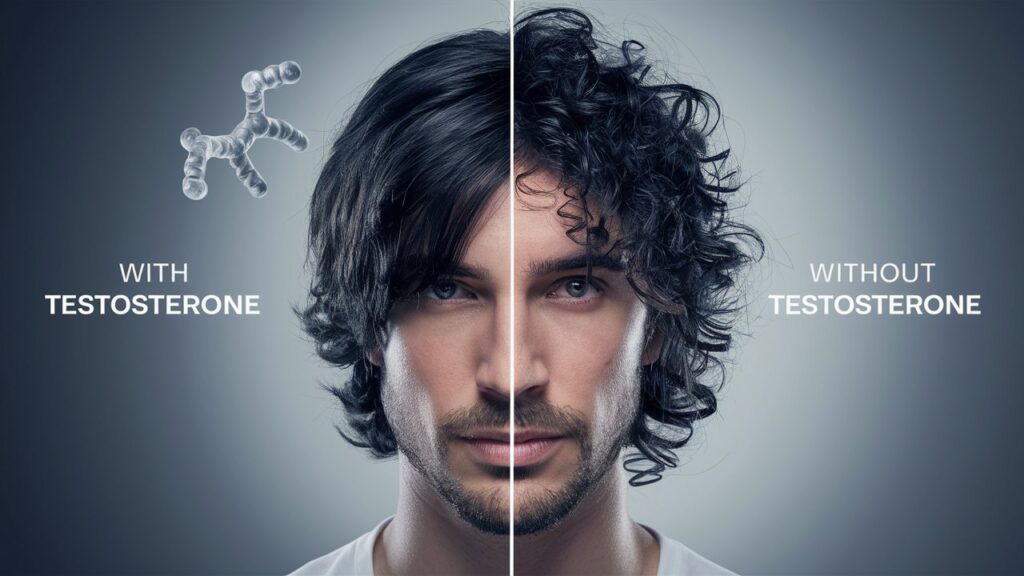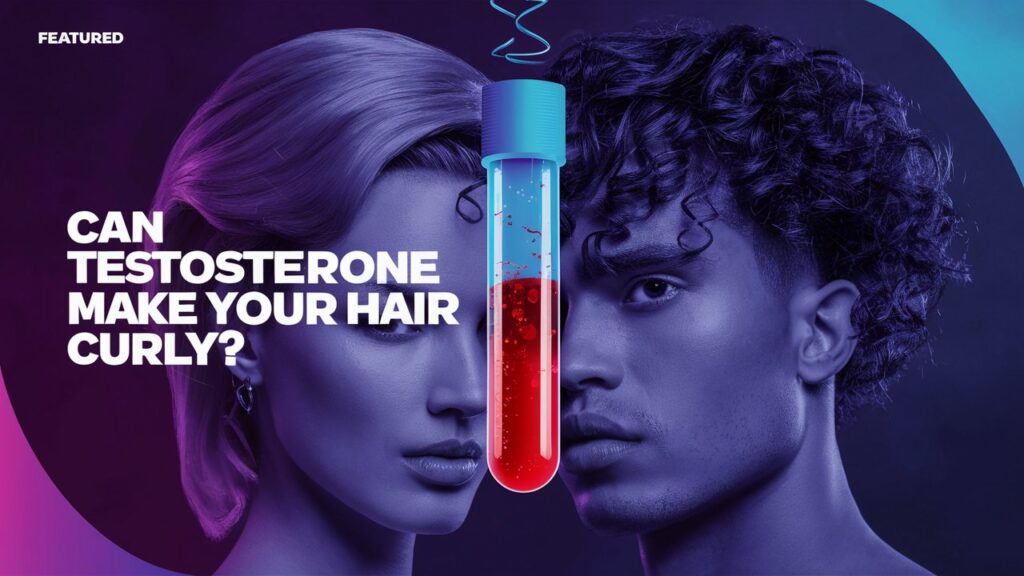Ever noticed how your hair seems to have a mind of its own, defiantly forming new curl patterns from one month to the next? If you’ve ever wondered, “Can testosterone make your hair curly?“, you’re onto a fascinating bit of hair biology. While testosterone alone doesn’t directly cause curly hair, this potent hormone can impact hair texture in some surprising ways.
Testosterone itself does not directly cause straight hair to become curly. However, increased testosterone can facilitate curlier hair textures by prompting follicles to produce thicker, coarser strands that form tighter curl patterns. This effect is most pronounced during hormonal events like puberty or with high androgen levels from conditions like PCOS.
Considering a DHT blocker could be beneficial if you’re concerned about how testosterone might be affecting your hair texture or even leading to hair loss. DHT, a byproduct of testosterone, can shrink hair follicles, contributing to thinning hair and altering your natural texture. Incorporating a DHT blocker supplement (for example https://rawsci.com/collections/skin-hair-and-nails) may help preserve your hair’s thickness and maintain its natural curl pattern by reducing the effects of DHT on hair follicles.
In this article, we’ll explore:
- The basics of hair biology and curl formation
- How testosterone influences hair growth and texture
- Other hormones that affect curl patterns
- Signs your curls are hormonally-influenced
- Tips for managing curly hair caused by hormones
Let’s untangle the curious case of testosterone and curly locks!
Basics of Hair Biology
Before we dig into hormones, let’s do a quick overview of hair anatomy. Your hair strands grow from follicles, tiny pocket-like organs in the skin’s surface. The hair shaft itself is made of compacted proteins called keratin.
While your genetics primarily determine your natural hair texture, hormones also play a key role in regulating the hair growth cycle. They can influence the length of the anagen (growth) phase, as well as characteristics like hair thickness.
Read More: Is Conditioner Good for Curly Hair?
The Testosterone Connection
For all genders, testosterone is a major hair growth facilitator starting at puberty. This androgen hormone signals follicles to sprout coarser, thicker strands during the transition into adulthood.
Here’s the fascinating part – the curlier hair gets as the diameter of individual strands increases. You’ve likely noticed men tend to have curlier body hair as testosterone levels rise. That same mechanism can occur on the scalp under certain circumstances.
“Testosterone is a natural precursor to the production of DHT, a more potent androgen that causes the hair follicles to miniaturize over time, affecting hair growth,” explains Dr. Amy McMichael, a dermatologist from Wake Forest Baptist Medical Center.
Higher levels of testosterone don’t always result in curlier head hair. But it can be a contributing factor if other catalysts are in play.
When High Testosterone Causes Curlier Scalp Hair

While rare, some women experience a temporary burst of curlier hair strands after giving birth. This fleeting texture change is caused by an acute spike in testosterone in the postpartum period.
In general, testosterone’s curl-enhancing effects are more likely to occur if you already have some natural wave or curl to your hair. Excessive testosterone can cause follicles to produce strands with greater diameter, amping up your hair’s natural ringlet pattern.
Another mechanism? Testosterone’s ability to dry out hair strands. Just like moving to a drier climate, the lack of moisture causes waviness or frizz to become more pronounced.
Read More: Is Curly Cut Worth it for Wavy Hair?
Other Hormonal Influences on Curls
Testosterone isn’t the only hormone that holds sway over your curl pattern. Estrogen, often viewed as testosterone’s biochemical counterpart, has been shown to promote smoother, silkier hair with more defined curls. Apart from this, you can also use the tongkat ali supplement available at : https://www.amazon.com/
Thyroid hormones are another crucial part of the curl equation. An overactive or underactive thyroid gland can cause hair texture disruptions:
- Hyperthyroidism: May produce excessive perspiration, drying out strands and increasing frizz.
- Hypothyroidism: Can result in coarse, dull hair shafts prone to breaking.
As you can see, multiple hormones interact in an intricate dance to influence hair curl and health. It’s a delicate biochemical balancing act!
Signs Your Curls Stem From Hormones
How can you tell if hormones like testosterone are to blame for your hair’s latest loop-de-loops? Keep an eye out for these telltale signs:
🔺 Sudden, unexplained curl changes: If your hair texture shifts rapidly without any adjustments in routine, products, etc., hormones could be the culprit.
🔺 Generalized texture shifts: As opposed to isolated curl changes from heat or product use, hormonally-driven texture transformations tend to occur across your full head of hair.
🔺 Other hormonal symptoms: Things like acne flare-ups, weight fluctuations, menstrual irregularities, and fatigue can sometimes accompany curl pattern shifts from imbalanced hormones.
If your curl alterations seem tied to major hormonal events like puberty, pregnancy, menopause, or a recent thyroid disorder diagnosis, that’s a strong clue that biochemistry is at play.
Tips for Managing Hormonally-Influenced Curls

While you can’t control which hormones course through your body, you can adjust your hair routine to accommodate hormonally-driven shifts.
If testosterone is making your hair curlier:
- Transition to more moisturizing products to combat dried-out strands and frizz
- Use curl-enhancing techniques like diffusing, plopping curls, and scrunching
- Limit heat styling to prevent exacerbating coarseness and damage
If other hormones like estrogen are defining your curls:
- Switch to a gel or curl cream to add hold and definition
- Try the rake & shake method to evenly distribute product through the curls
- Use a deep conditioning treatment weekly to hydrate and smooth the strands
If your hair texture seems dysregulated from thyroid issues, managing that underlying condition through medication and lifestyle changes should help get your locks back on track.
And remember, major hormonal shifts like those in pregnancy or menopause are temporary. With some adjustments, you can absolutely rock your “new” curls until your hormone levels stabilize again.
Closing Thoughts
As you can see, the relationship between testosterone and curly hair is complex yet fascinating. While testosterone alone doesn’t make hair curly, it can facilitate curl formation through mechanisms like increasing hair strand thickness.
Other hormones like estrogen and thyroid regulators also intricately govern curl patterns. When these chemical signals in your body ebb and flow, your luscious locks often go along for the ride.
At the end of the day, hormones are simply your body’s personal orchestra conductors, subtly guiding the tempo of changes like hair growth and texture over time. Learning to work with the rhythms can put you in perfect harmony with your ever-evolving tresses.
“The beauty of curls is their wild, unbridled nature. Hormones simply turn up the volume!” – Marc Daniels, Curl Expert
So embrace those luscious coils and waves, knowing they are a reflection of your body’s unique biochemical symphony. After all, curly hair always deserves an encore!
Workflows will evolve with advancements in cross copy and paste. Users will save time by eliminating repetitive tasks. Imagine copying notes on a phone and pasting them on a laptop. This ability will enhance productivity and creativity.
Collaboration will also benefit. Teams can share content across devices with ease. This will improve communication and project management. As workflows evolve, teamwork will become more efficient and dynamic.

Tina Hudson is the voice behind Fashion Ticky, a fashion blog she started featuring the latest trends in fashion and beauty. With her finger on the pulse of what’s hot each season, Tina shares outfit ideas, makeup tutorials, and styling tips to help her devoted readers develop their own fabulous sense of fashion. When she’s not blogging, you can find this savvy stylist hunting for vintage treasures and snapping Instagram-worthy travel pics with her French bulldog in tow.
